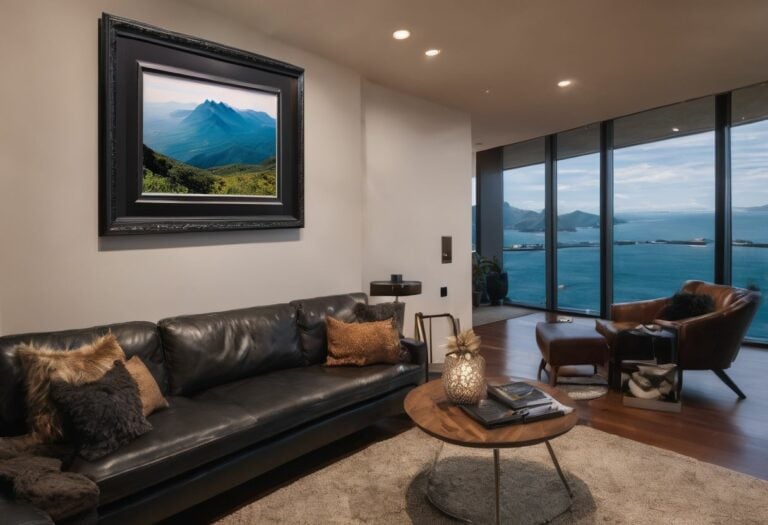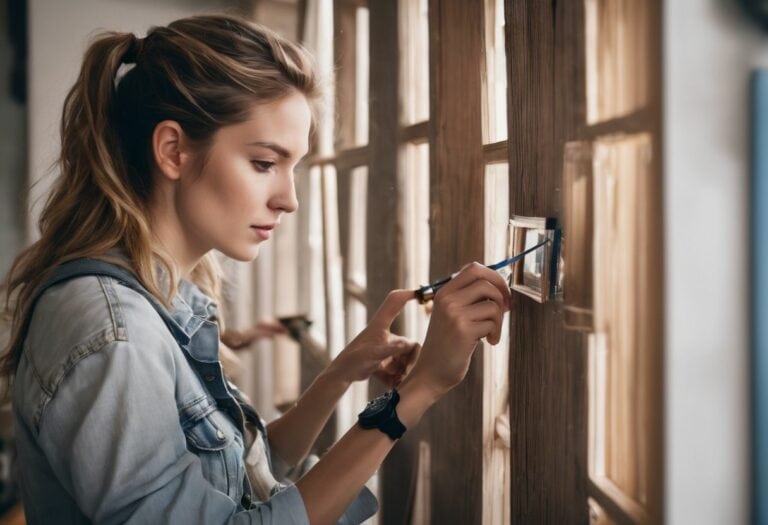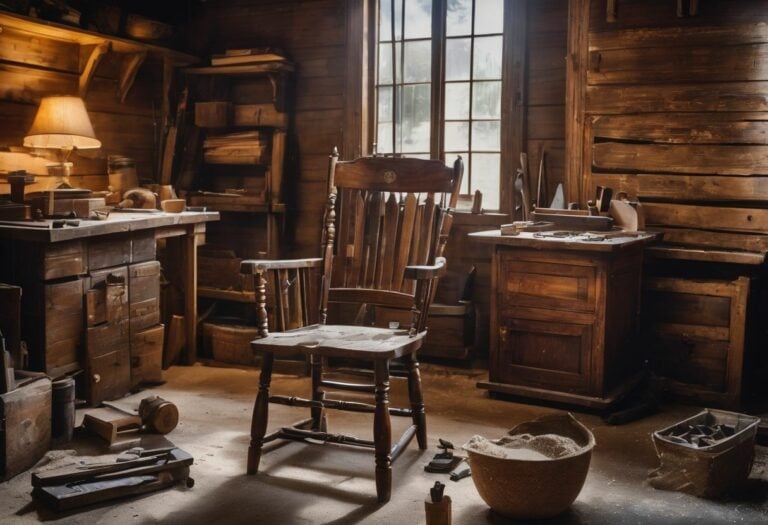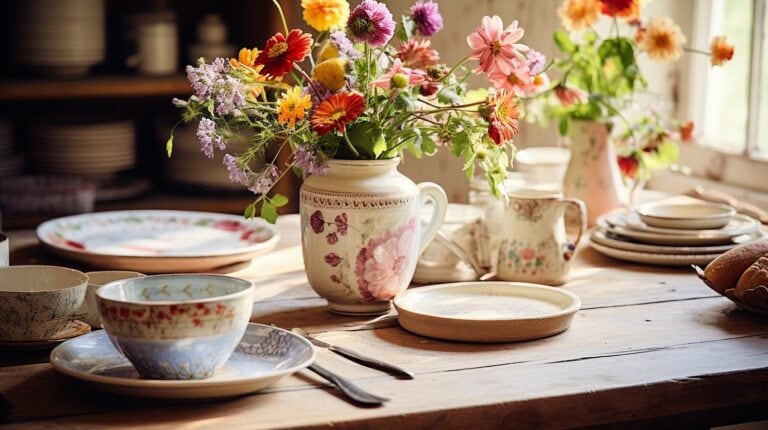Stunning Showdown: Modern vs Minimalist Interior Design Trends
As we stand in the heart of our homes, pondering over swatches and Pinterest boards, the question of how to curate our spaces often lingers like a quiet challenge. Perhaps you’re someone who dreams of injecting new life into your home but finds yourself in a tug-of-war between modern elegance and minimalist zen.
It’s a common crossroads; selecting an aesthetic that embodies both comfort and sophistication is no small feat.
Believe me, the road to finding that perfect balance was familiar territory during my own design journey. Like many, I longed for my abode to emulate the poise of a glossy spread while maintaining warmth and personality.
Modern vs Minimalist Interior Design

The truth is, both modern and minimalist designs champion uncluttered spaces with streamlined simplicity – it’s no wonder they’re cherished by those yearning for chic yet practical living areas.
I’m here now to share insights gained from delving into these interior realms, ready to help you navigate their subtle nuances. Our exploration will demystify jargon-filled descriptions and spotlight key characteristics that can transform your dwelling into an inviting sanctuary without crowding your comfort or cramping your style.
Are you prepared to craft a space that reflects your most refined preferences? Join me as we embark on this exciting venture together!
Understanding Modern and Minimalist Interior Design
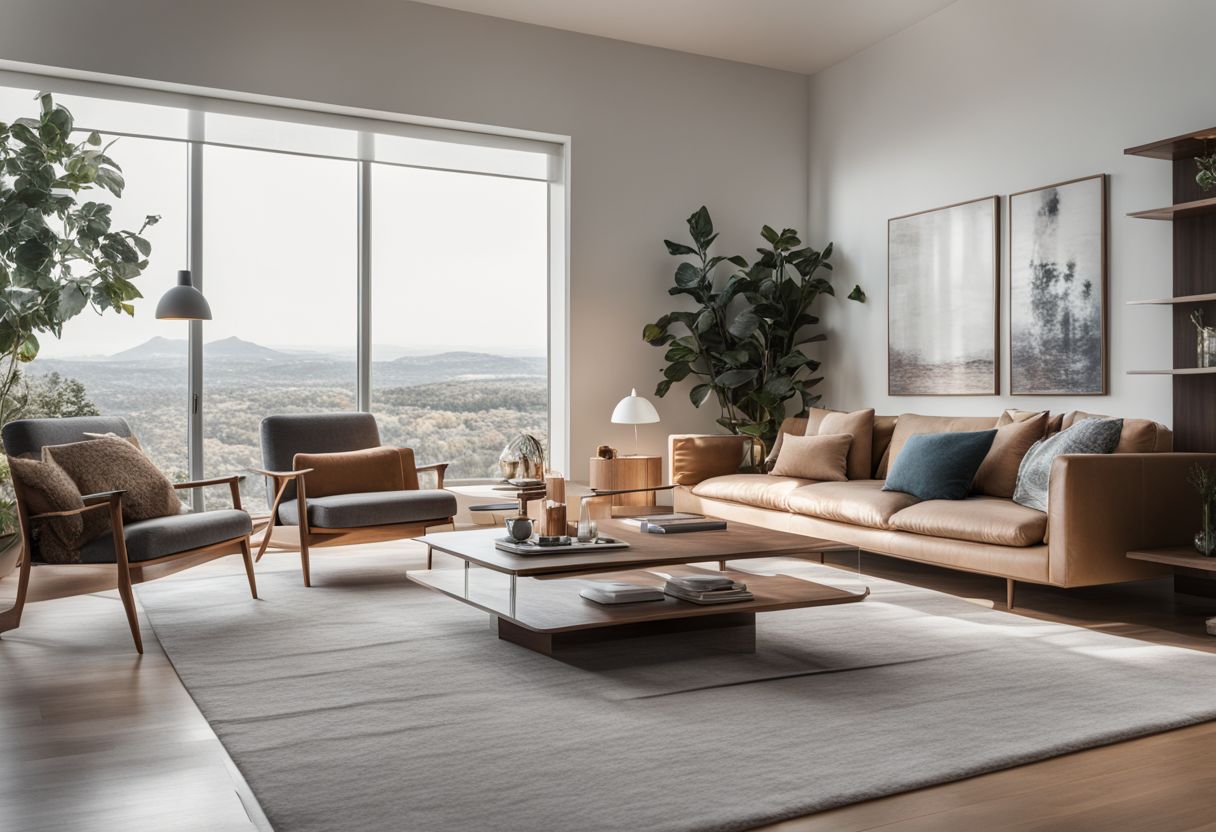
Modern interior design is characterized by sleek lines, minimal ornamentation, and a focus on function. In contrast, minimalist design emphasizes simplicity, clean lines, and a reduction of unnecessary elements to create a calm and serene space.
Both styles prioritize creating uncluttered environments but differ in their overall aesthetic approach.
Defining the terms
Minimalist interior design is about keeping things simple. I focus on what’s important and get rid of extra stuff that’s not needed. This means picking furniture and decor that are basic but beautiful.
Everything in a minimalist space has a place and a reason to be there. It’s like the saying “less is more.” The idea is to have more space, less clutter, and find peace in my rooms.
In modern interior design, I go for a look that matches today with clean lines and neutral colors. It usually includes lots of natural materials like wood or leather. Modern spaces feel open because they have big windows letting in all the light from outside.
Furniture looks sleek and often has cool shapes. This style started way back with the modernism movement where people wanted their homes to match the new skyscrapers going up.
Both these styles give off different vibes but share some common ground – simplicity, use of natural light, and an uncluttered approach to living spaces.
Key features and characteristics
I love exploring how different design styles make a home feel special. Let’s take a look at the main features of modern and minimalist interior design.
- Modern design sprang up in the 20th century. It blends form and function where every piece serves a purpose.
- Furniture often takes cues from the mid – century with clean lines and organic shapes.
- Rooms are open and airy, making spaces feel larger than they are.
- Color palettes mix neutral shades with bold accents to create a dynamic look.
- Materials like steel, glass, and concrete are common, offering sleek textures.
- Lighting is artistic, serving as sculptures as well as light sources.
- Minimalism is about keeping only what you need. It aims to create peace through uncluttered spaces.
- Color schemes are very calm, using whites, beiges, and greys to soothe the eye.
- Lines are straight or gently curved, reducing visual noise.
- Natural light is important. Big windows help connect indoor spaces with the outside world.
- Furniture is simple but high – quality; it stands out by not trying to stand out.
- Decorations are few but meaningful. Each item chosen has a place and a reason to be there.
The Differences Between Modern and Minimalist Design
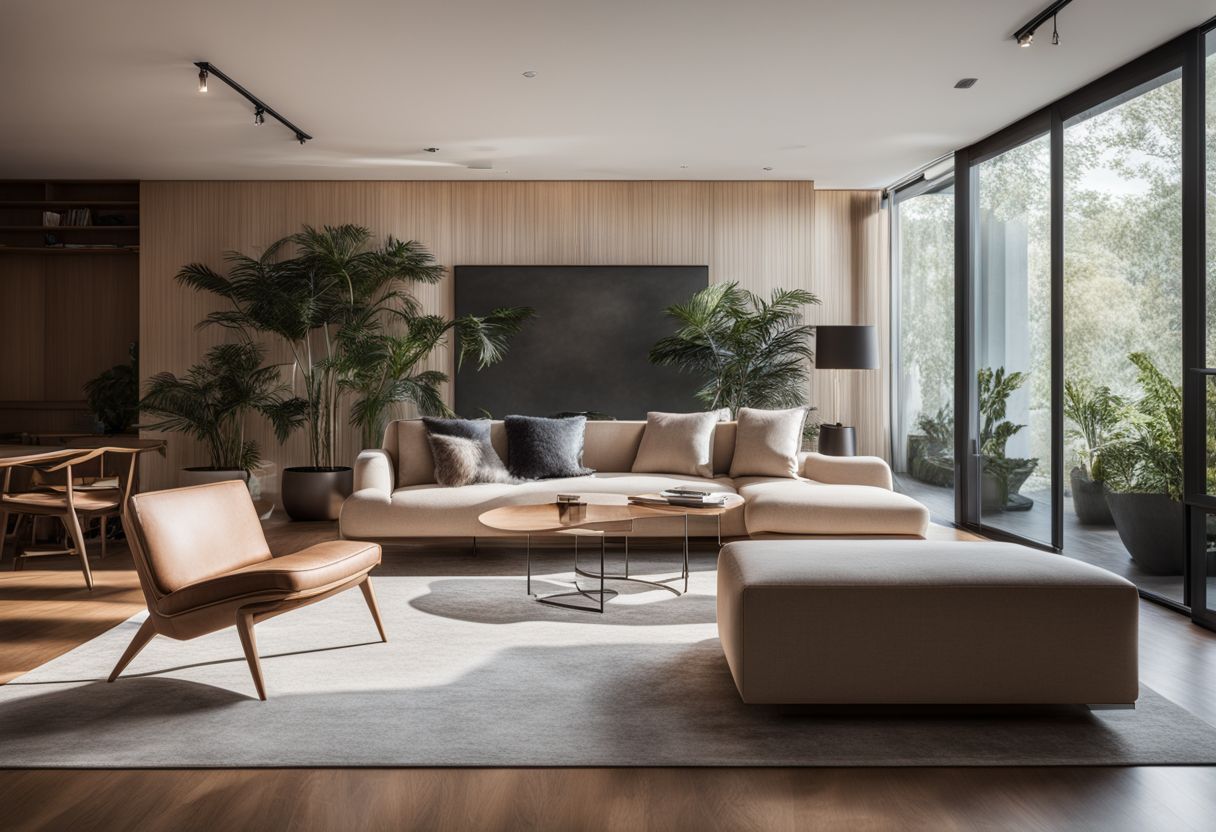
Modern interior design draws inspiration from the modernist movements of the early to mid-20th century, focusing on clean lines, geometric shapes, and a mix of materials. On the other hand, minimalist design embraces simplicity and functionality with a focus on neutral colors, natural light, and streamlined furniture and decor.
Origins and influences
Minimalism in interior design got a lot of its style from places like Scandinavia. It also takes ideas from the mid-century modern movement which loved simple forms and function. Think about how clean lines and open spaces make you feel relaxed and free.
People wanted homes that felt calm, so they picked furniture and things that didn’t crowd their rooms.
Scandinavian designers show us how to mix cozy with simple. They use things like soft fabrics, warm woods, and plants to make spaces inviting yet still very clear and open. This way of making homes look good has spread all around the world.
Now let’s talk about colors and materials in these two styles.
Use of color and materials
Exploring the use of color and materials in modern and minimalist interior design sets the tone for the ambiance we aim to create. Here are some key points to consider:
- Neutral Palette: Both styles embrace neutral colors, creating a serene and cohesive atmosphere that complements a contemporary lifestyle.
- Material Selection: Minimalist interior design favors natural materials like wood, stone, and metal, emphasizing their raw beauty and simplicity.
- Contrasting Textures: Modern design incorporates contrasting textures such as glass, chrome, and lacquered surfaces to add depth and visual interest to the space.
- Emphasis on Form: Minimalist interiors prioritize clean lines and simple forms, using materials with understated elegance to enhance the overall aesthetic.
- Pop of Color: In modern design, a pop of bold color may be introduced sparingly against a neutral backdrop, adding vibrancy without overwhelming the space.
- Cohesive Materials: Both styles emphasize the importance of using materials that harmonize with one another, contributing to a unified and polished look throughout the home.
- Natural Elements: Incorporating natural elements like plants, stones, or water features can bring a sense of tranquility into both modern and minimalist interiors while connecting with nature’s calming influence.
- Balance in Textiles: To complement the minimalism in decor, textiles in modern design add warmth and comfort while still maintaining an overall sleek aesthetic through careful selection of patterns and textures.
Furniture and decor
When it comes to modern interior design, sleek and clean lines are the hallmark. Furniture and decor often showcase a mix of materials such as glass, metal, and wood.
- Clean lines characterize modern furniture and decor.
- Use of geometric shapes is common in modern interior design, adding a contemporary touch to spaces.
- Neutral color palettes dominate modern interiors, creating a sense of openness and airiness.
- Modern furniture often prioritizes functionality without compromising on style, making it ideal for practical living spaces.
- Decor in modern design tends to be minimal yet impactful, with strategically placed statement pieces that draw the eye while maintaining the overall simplicity.
- Contemporary art pieces or abstract sculptures can serve as focal points in modern interiors, adding visual interest to the space.
- Minimalist furniture features clean silhouettes and emphasizes practicality over ornamentation.
- Neutral colors like white, beige, and gray dominate minimalist interiors, contributing to a serene atmosphere.
- Multi – functional furniture is often incorporated into minimalist spaces to maximize utility while minimizing clutter.
- Decor in minimalist design aims to achieve visual balance by using only essential items that complement the overall aesthetic without overwhelming the space.
- Indoor plants are commonly used as natural decor elements in minimalist interiors, bringing a touch of nature into the space without disrupting its clean lines.
- The use of negative space is essential in minimalist design, allowing furniture and decor to stand out against uncluttered backgrounds.
Benefits and drawbacks
As we move from discussing the specific elements like furniture and decor, we naturally come to consider the benefits and drawbacks of both modern and minimalist interior design styles. These two approaches, while distinct, share a common goal of creating spaces that are both aesthetically pleasing and functionally sound. Yet, they each come with their own set of advantages and challenges that are important to understand for anyone looking to embrace these styles in their home.
| Style | Benefits | Drawbacks |
|---|---|---|
| Modern |
|
|
| Minimalist |
|
|
Both styles have their merits, but it’s crucial to align them with your personal lifestyle and preferences. As we make design choices, it’s essential to be mindful of how these styles will affect our daily lives and ensure they reflect who we are.
Incorporating Modern Design in Your Home
Choose contemporary furniture pieces with clean lines and sleek finishes, embrace the latest technology in your home decor, and find a balance between form and function for a modern touch.
Ready to transform your space with modern design? Keep reading to discover more tips and inspiration!
Choosing contemporary furniture
When choosing contemporary furniture, it’s important to consider the following factors:
- Look for pieces with sleek lines and geometric shapes that embody modern design principles while offering comfort and functionality.
- Opt for furniture made of materials like metal, glass, or polished wood to achieve a sophisticated and minimalist aesthetic.
- Consider selecting furnishings with bold or neutral colors to create a striking contrast or a harmonious blend within your living space.
- Incorporate statement pieces such as armchairs, benches, or cabinets that showcase innovative designs and artistic flair.
- Explore furniture brands known for their contemporary styles like Florence Knoll, Bulthaup, or other reputable designers in the industry.
Utilizing technology
In modern interior design, technology plays a crucial role in enhancing the functionality and convenience of a space. Smart home automation allows for seamless control over lighting, temperature, electronic devices, and security systems.
This integration of technology aligns with the contemporary nature of modern design, where cutting-edge advancements are embraced to create efficient and innovative living spaces. Incorporating wireless devices and space-saving solutions further complements the sleek and streamlined characteristics of modern interior design.
Minimalist interior design intersects with technology through a focus on smart home integration and the utilization of wireless devices to maintain an uncluttered environment. The incorporation of minimalist principles aligns with the simplicity and efficiency that smart home technology offers.
Balancing form and function
When it comes to balancing form and function in interior design, it’s important to ensure that the aesthetic appeal of a space doesn’t compromise its practicality. In modern design, this balance is achieved by prioritizing sleek lines, open spaces, and innovative yet functional furniture pieces.
It embraces technology seamlessly into the design through smart home features and multifunctional furniture to maintain a contemporary look while serving various purposes efficiently.
In minimalist design, the emphasis on clean lines and uncluttered spaces reinforces the idea that every element should serve a purpose without sacrificing style. This approach often incorporates simple yet elegant furniture pieces designed with practicality in mind, allowing for an unobtrusive flow throughout the space while achieving an understated sophistication.
Incorporating Minimalist Design in Your Home
Choosing neutral colors and utilizing natural light are essential elements of minimalist design. Embracing minimalism in decor and decluttering your space will also help achieve the clean, serene aesthetic of this style.
Choosing neutral colors
Selecting the right color scheme is crucial for achieving a minimalist interior. Neutral colors create a serene and harmonious atmosphere, serving as the foundation of this design style. Here are some tips for choosing neutral colors:
- Start with whites, which can range from crisp pure whites to warmer off – whites and creamy tones.
- Consider incorporating shades of beige, such as tan, khaki, or taupe, to add warmth and depth to the space.
- Utilize soft pastels like light grays or pale blues to enhance a sense of tranquility without deviating from the minimalist palette.
- Experiment with different textures within the neutral color scheme to introduce visual interest while maintaining a clean aesthetic.
- Embrace natural materials such as wood or stone in their raw, untreated forms to complement the neutral color palette.
- Use strategic accents of black to create contrast and definition within the space without disrupting the overall minimalist ambiance.
Utilizing natural light
In interior design, utilizing natural light is essential for creating a bright and inviting space. Natural light has numerous benefits, including boosting mood and productivity while reducing the reliance on artificial lighting.
In minimalist interior design, embracing natural light is integral to creating an open and airy ambiance. This can be achieved by strategically placing furniture to allow sunlight to flow into the room, choosing window treatments that maintain privacy without blocking out light, and using reflective surfaces to maximize the distribution of natural light throughout the space.
Furthermore, incorporating elements such as glass walls or doors can help facilitate the seamless entry of natural light. Adding mirrors opposite windows enhances the penetration of sunlight deeper into the room by reflecting it off their surfaces.
Embracing natural materials for flooring and furniture allows for better absorption and diffusion of daylight. By harnessing these techniques, one can optimize the use of natural light in a minimalist interior design setting.
Embracing minimalism in decor and clutter
Embracing minimalism in decor and clutter is important for creating a serene and functional living space. It involves:
- Choosing neutral colors like white, beige, or light gray to create a sense of openness and tranquility.
- Using simple and purposeful furniture to minimize visual clutter and promote functionality.
- Incorporating natural elements such as plants or natural materials to bring a touch of warmth and vitality.
- Opting for multi – functional storage solutions to keep belongings organized and out of sight.
- Selecting minimalist decor pieces with clean lines and subtle textures to enhance the overall simplicity of the space.
Finding Your Style
Understanding your lifestyle and preferences is crucial in finding the perfect interior design style for your home. By blending modern and minimalist elements, you can create a space that reflects your personal taste while also embracing the functionality and simplicity of both styles.
Understanding your lifestyle and preferences
I need to understand my lifestyle and preferences before choosing between modern and minimalist interior design. Minimalist design focuses on simplicity, reducing clutter, and having only necessary items.
On the other hand, modern design has a sleek and contemporary feel with clean lines and open spaces. Factors like my daily routine, the amount of stuff I have, and my love for technology will help me decide which style suits me best.
My day-to-day activities at home play a significant role in determining whether I lean towards a more minimalistic approach or a modern one. Additionally, considering how much value I place on maintaining an organized space versus embracing new technologies will guide me in making the right choice for designing my living space.
Blending modern and minimalist elements
Blending modern and minimalist elements creates a harmonious space that is both functional and serene. To achieve this, consider the following:
- Emphasize clean lines and simple shapes in furniture and decor to maintain a minimalist aesthetic while incorporating modern design principles.
- Choose a neutral color palette with occasional pops of color to add a modern touch to the minimalist space.
- Select furniture that balances form and function, focusing on practicality without compromising the overall minimalist ambiance.
- Incorporate natural materials such as wood, stone, and metal to bring warmth and texture to the modern minimalist space.
- Integrate technology seamlessly into the design, ensuring that it complements rather than overwhelms the minimalist elements.
- Utilize open spaces strategically to maintain a sense of minimalism while incorporating modern functionality.
Examples of Modern and Minimalist Interior Design
Explore real life examples of modern and minimalist interior design to gain inspiration for your own space. From sleek, contemporary furniture to clean, neutral color palettes, these examples showcase how the two styles can be implemented in a variety of rooms within a home.
Real life examples
Ishka Designs showcases minimalist interior design, providing inspiration for creating serene and beautiful spaces. Some examples include:
- Incorporating natural materials such as wood and stone to create a warm and inviting atmosphere.
- Embracing a neutral color palette with pops of green from indoor plants to bring life into the space.
- Utilizing clean lines and uncluttered spaces to create a sense of calm and tranquility.
- Maximizing natural light through strategically placed windows or skylights to brighten the room without overwhelming it.
- Implementing multi – functional furniture that serves both practical and aesthetic purposes, enhancing the minimalist style while maximizing space.
Inspirational photos
Now, let’s take a visual journey from real-life examples to inspirational photos that showcase modern and minimalist interior designs. These images capture the essence of both styles, highlighting their key features and characteristics.
By exploring these visuals, you can gain a deeper understanding of how color palettes, furniture choices, and decor elements come together to create stunning contemporary or minimalist spaces in homes.
As you browse through these inspirational photos, notice the clever use of natural light, neutral colors, and uncluttered living areas that embody the beauty and functionality of modern and minimalist interior design.
As we immerse ourselves in these inspiring visuals, let’s keep in mind the current trend towards minimalism with plants as showcased by Ishka Designs. This approach infuses nature into minimalist spaces, adding an organic touch that harmonizes with clean lines and simplicity.
Finding a Balance: Incorporating Both Styles
Incorporating both modern and minimalist design in one space requires careful planning and consideration. By harmonizing the clean lines of minimalist design with the sleek elements of modern design, you can create a cohesive and balanced interior that reflects your personal style.
Coexisting in one space
When blending modern and minimalist styles in one space, it’s crucial to find harmony. I ensure the coexistence of both by using neutral colors and sleek furniture from modern design while also embracing minimalism by decluttering and letting natural light flow through the space.
The mix of contemporary furniture and minimalistic decor elements helps in achieving a balanced look that is functional yet visually appealing.
Finding a balance between modern and minimalist design creates a cohesive look that reflects simplicity with a touch of sophistication. By paying attention to materiality, I can seamlessly integrate different elements into my home without compromising on the essence of either style.
Creating a cohesive design
Coexisting in one space offers the opportunity to blend modern and minimalist elements into a harmonious design. Achieving cohesive design shows attention to detail and organization, ensuring each room has its own unique identity while contributing to the overall aesthetic of the home.
By seamlessly integrating modern and minimalist styles, it’s possible to create a balanced and visually appealing living space that embodies functionality, simplicity, and sophistication.
Incorporating both styles allows for an interplay of clean lines, natural materials, neutral colors, and contemporary furniture. This can elevate the visual appeal of spaces such as living rooms, bedrooms, kitchens, or bathrooms.
Tips for Choosing Between Modern and Minimalist Design
Consider your lifestyle and preferences when choosing between modern and minimalist design. Determine your budget for the project and evaluate your space to see which style would work best for you.
Consider your lifestyle and preferences
When deciding between modern and minimalist interior design, it’s important to think about your lifestyle and what you prefer. If you have a busy household with kids and pets, a more durable and practical modern design might suit you best.
On the other hand, if you crave simplicity and tranquility in your living space, minimalist design may be the way to go.
While considering your lifestyle, think about how much time you want to spend on maintaining your home decor. Modern designs often incorporate technology and sleek materials that require minimal upkeep.
Alternatively, minimalist decor promotes openness with fewer items around, making cleaning easier. Additionally, assessing your personal preferences for color schemes can help guide your decision between the boldness of modern palettes versus the calming neutrals of minimalism.
Determine your budget
To begin, understanding your budget is essential when considering modern or minimalist interior design. A cost-effective option, minimalist style offers a more wallet-friendly approach.
Recent surveys show that many people are choosing smaller homes to embrace this lifestyle. It’s important to assess how much you can comfortably spend and which style best fits your financial scope before delving into the world of interior design.
Moving forward to exploring the key features and characteristics of each design style will provide a better perspective on how they differ from one another while making an informed decision based on your preferences and budget.
Evaluate your space
When evaluating your space for modern or minimalist design, consider the layout and function. Take note of natural light sources and how they enter the room throughout the day. Also, assess how you currently use your space to understand what changes may be needed to align with either style.
Keep in mind that minimalist design emphasizes simplicity and functionality while modern design allows for more flexibility in decor choices.
Consider incorporating minimalism if you prefer a clutter-free environment that promotes calmness, as this can guide your decisions when choosing furniture, colors, and decor elements.
Conclusion
In conclusion, modern and minimalist interior design each offer a distinctive approach to creating stylish and functional living spaces. Both styles focus on simplicity, clean lines, and open spaces.
Understanding the key differences can help in choosing the best fit for your home. Whether leaning towards the sleekness of modern design or embracing the calmness of minimalism, finding the right balance can result in a harmonious and inviting space that reflects personal taste and lifestyle preferences.
Ultimately, combining elements from both styles allows for a personalized approach that maximizes comfort while maintaining an uncluttered aesthetic.
FAQs
1. What’s the difference between modern and minimalist interior design?
Modern interior design is all about new styles with lots of features, while minimalist interior relies on simplicity and fewer items.
2. Can I use plants in minimalist interior design?
Yes, you can use plants to add life and freshness to a minimalist space without adding clutter.
3. How do I know if minimalist living is right for me?
If you like spaces that are simple, clean, and not full of things, then a minimalist living style might be good for you.
4. What kind of furniture fits best in a minimalist home?
Look for furniture like benchtops or stools that have simple designs and don’t take up too much space.
5. Does lighting matter in modern vs. minimalist decor?
Yes! Natural lighting is important in both styles but it’s very key in minimalism to help make the room feel peaceful and open.



